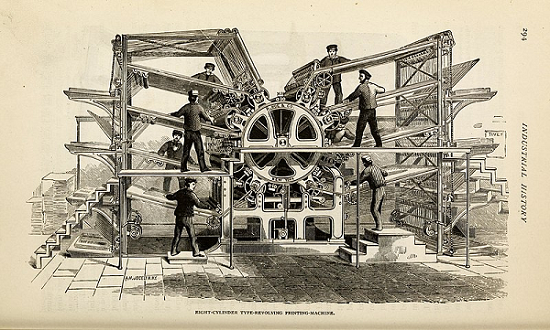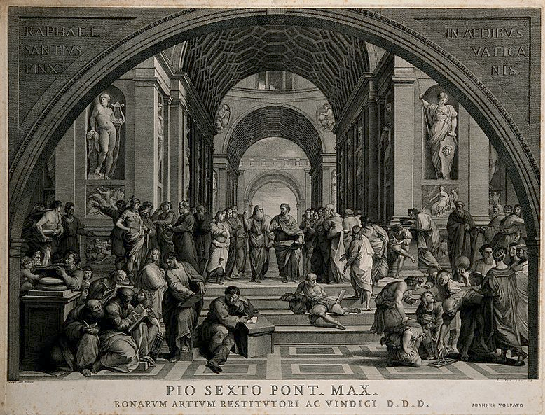

The period between the 14th century and the 17th century was a period of many changes in European society. People started urban lifestyles and became more civilised. The invention of the Printing press was another achievement of European society. It allowed Artists, Painters and Writers to gain influence.
The invention of printing gave people an opportunity to read and gain new ideas. An idea of connection with history also emerged in Europe and people started comparing new cities to old Greek and Romans.

Eight Cylinder Type-revolving Printing Machine
Bolles, Albert Sidney, 1846-1939, No restrictions, via Wikimedia Commons
The geocentric theory of the Church was proved false, by scientists. The Europeancentric view that the mediterranean sea was the centre of the earth, was also challenged and proven false. The nineteenth-century historians coined the term ‘Renaissance’ to describe the period of change and new ideas in European society. In 1860 the famous historian Jacob Burckhardt wrote the book ‘The Civilization of Renaissance in Italy’ in which he describes how a new culture of Humanism changed Italian culture from the 14th to the 17th century. His idea was that modern man can think for himself and he is not guided by the church.

Gathering of Renaissance Artists
Welcome Library, London : Copyrighted work available under Creative Commons Attribution only licence CC BY 4.0 http://creativecommons.org/licenses/by/4.0/
There were significant changes seen in European societies, between the 14th and 17th centuries. Historians called this era ‘Renaissance’.
The term Renaissance means ‘rebirth’. According to historians, it was the revival of the glory of ancient cities of Europe.
There were many reasons for the Renaissance, it brought new ideas and changes in the thinking of people.
The interaction between Eastern and Western people increased and it led to the arrival of new ideas. This was due to trade between the Byzantine empire and the Islamic empire.
Multiple wars between Islam and Christianity led to more intervention of both cultures.
The new scientific discoveries which discarded geocentric and euro-centric theory gave people new knowledge and falsified the Church.
In the 16th century, the decline of feudalism led to a new social order in European society.
The fall of the Feudal class gave birth to the new middle class and they were generally regarded as townspeople who thought themselves more civilised than the rural masses.
Towns like Rome, Venice and Florance became the centre of art and culture.
After the fall of Ancient Rome, many towns which were cultural and political centres of Italy became ruined.
There was no central authority, the Pope was not seen as a political figure, he was a sovereign in himself.
Western Europe was reshaped by Feudal lords and Latin churches.
Eastern Europe was influenced by the Byzantine empire and Muslim Empire.
The influence of other cultures was giving the weak and broken Italy a chance to revive itself.
Trade was the most prominent factor in the revival of Italy, trade between the Byzantine empire and Islamic countries opened up the ports of Italy, which brought revenue and foreign culture with itself.
Italian ports also played a major role in the silk route. In the 12th century, the trade between Mongolia, China and western countries started and they all crossed through Italy.
Italian cities gradually saw themselves separate from any big empires, they declared themselves free city-state.
Venice and Florance were the two most famous Republics and there were many independent city-states throughout Italy, which were ruled by princes.
Genoa was another vibrant city after Venice and Florence.
The situation of Italy was completely different from the rest of Europe, there were no dominant Clergy class or feudal lords in Italy.
Rich businessmen, traders and bankers actively participated in the government of the city.
People were proud citizens of these city-states.
The revival of ancient Italian cities started in the 10th and 11th centuries. The towns were re-emerging and the upsurge in population happened.
In these new towns, knights, merchants, craftsmen, workers and other professionals lived side by side and they married each other.
There was a social hierarchy present but it was very complex and different from other parts of Europe.
The 13th-century city was starting to form a republic, although the participation of the common mass was restricted yet, some portion of the population took part in meetings and debates.
In the 14th century again, the cities were turning from republics to the aristocracy. The feudal lords were merged with republic institutions and formed a new kind of government.
Some cities like Venice did not have a feudal lordship but only merchant aristocracy, which called themselves Noble and made their position hereditary.
The Cultural change in Europe started in the 12th century. The most significant change in Europe was seen in Italy. The city-states of Italy re-emerged from the ashes of the Ancient Roman empire. After the fall of the Roman empire, the glory of Europe was lost, but with the emergence of the city-states of Italy, it remerged. This was a period of transition from the dark ages to the modern ages. The historians gave the term ‘Renaissance’ to this period. The term Renaissance means rebirth. The 14th century was a period of new ideas and new inventions. People started questioning the authority and claims of the Church. Scientists and artists played a vital role in the occurrence of the Renaissance. The scientific discoveries that earth was not the centre of universes discarded the theories given by the Church. The invention of the printing press was another factor which improved the knowledge of people and allowed new critical ideas to emerge. Overall, the period between the 12th and 17th centuries in Europe was filled with many changes, many new city-states, empires and ideas emerged.
Q1. What were the effects of the Renaissance?
Ans. With the Renaissance, the modern ages started, many new city-states in Europe emerged, new ideas, literary works, scientific discoveries and many more changes came, which paved the way to modern society.
Q2. Who gave the term Renaissance?
Ans. The Term Renaissance was very first used by 19th-century Historian Jacob Burckhardt. He was a professor at the University of Switzerland.
Q3. What were the significant features of the city-states of Italy?
Ans. Some significant features are −
These city-states were republics.
They had a Merchant aristocracy, which was hereditary.
People of all classes used to live together.
Complex social structure.
Q4. What scientific discoveries happened in the Renaissance?
Ans. The invention of the Printing press was most significant. The other important discovery was earth not being the centre of the universe and Europe was not the centre of the world.
Q5. What was the major event that led to the revival of city-states in Italy?
Ans. The trade between the Byzantine empire and Islamic empires opened the ports of Italy and the operation of the silk route which also came to the ports of Italy, were the major events in the revival of the city-states of Italy.